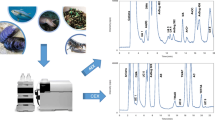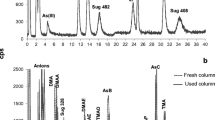Abstract
A multi-isotope spike species-specific isotope dilution (MI-SSID) calibration strategy in connection with gas chromatography-inductively coupled plasma mass spectrometry was applied to evaluate different extraction procedures for the speciation analysis of phenyltin (PhT) compounds in biological materials: mussel tissue BCR CRM-477 and fish tissue NIES-11. Three different isotope-enriched PhT compounds, 118Sn-enriched monophenyltin (MPhT), 122Sn-enriched diphenyltin (DPhT), and 124Sn-enriched triphenyltin (TPhT), were used for the preparation of spikes to follow and correct for six possible interconversion reactions between PhT species that can take place in a sample. The acidity of the extractant, the presence of complexing reagents, and the use of ultrasonic or microwave agitation were found to affect the degradation of PhT compounds. No formation of PhTs through phenylation and negligible degradation of MPhT to inorganic tin were observed under the conditions investigated. The degree of degradation increased with increased acidity of extractant and when ultrasonication or microwave agitation was used. Under relatively mild extraction conditions, the degradation factors for DPhT and TPhT in the two reference materials studied were found, using MI-SSID, to be between 10 and 55% and 2 and 10%, respectively. Using the degradation factors, we calculated corrected concentration values for the organotin species. When microwave extraction at high power output was used, hydrogen radicals were formed that can enhance the degradation of DPhT and TPhT. The hydrogen radicals were trapped using N-tert-butyl-α-phenylnitrone and detected by electron spin resonance spectrometry. The effect of different extraction parameters on the degradation of PhT compounds in biological samples is discussed.





Similar content being viewed by others
References
Pereiro IR, Schmitt VO, Szpunar J, Donard OFX, Lobinski R (1996) Anal Chem 68:4135–4140
Kumar SJ, Tesfalidet S, Snell JP, Van DN, Frech W (2004) J Anal At Spectrom 19:368–372
Pellegrino C, Massanisso P, Morabito R (2000) Trends Anal Chem 19:97–106
Abalos M, Bayona JM, Quevauviller P (1998) Appl Organomet Chem 12:541–549
Kumar SJ, Tesfalidet S, Snell J, Frech W (2003) J Anal At Spectrom 18:714–719
Berg M, Arnold CG, Müller SR, Mühlemann J, Schwarzenbach RP (2001) Environ Sci Technol 35:3151–3157
Ariese F, Cofino W, Gomez-Ariza JL, Kramer GN, Quevauviller P (1999) J Environ Monit 2:191–196
Alonso IJG, Encinar J, González RP, Sanz-Medel A (2002) Anal Bioanal Chem 373:432–440
Morabito R, Soldati P, de la Calle Gutinas MB, Quevauviller P (1998) Appl Organomet Chem 12:621–634
Diemer J, Heumann KG (1997) Fresenius J Anal Chem 357:74–79
Tirez K, Brusten W, Cluyts A, Patyn J, De Brucker N (2003) J Anal At Spectrom 18:922–932
Reifenhäuser C, Heumann KG (1990) Fresenius J Anal Chem 336:559–563
Minami H, Cai WT, Kusumoto T, Nishikawa K, Zhang Q, Inoue S Atsuya I (2003) Anal Sci 19:1359–1363
Hinojosa Reyes L, Marchante Gayón JM, Garcıa Alonso JI, Sanz-Medel A (2004) J Anal At Spectrom 19:1230–1235
Hintelmann H, Evans RD (1997) Fresenius J Anal Chem 358:375–378
Ruiz Encinar J, Monterde Villar MI, Gotor Santamarıa V, Garcia-Alonso JI, Sanz-Medel A (2001) Anal Chem 73:3174–3180
Qvarnström J, Frech W (2002) J Anal At Spectrom 17:1486–1491
Encinar JR, Rodríguez-Gonzalez P, Alonso JIG, Sanz-Medel A (2002) Anal Chem 74:270–281
Van DN, Muppala SRK, Frech W, Tesfalidet S (2006) Anal Bioanal Chem 386:1505–1513
Rodríguez-Gonzalez P, García Alonso JI, Sanz-Medel A (2004) J Anal At Spectrom 19:767–772
Poperechna N, Heumann KG (2005) Anal Bioanal Chem 383:153–159
Rodríguez-Gonzalez PR, García Alonso JI, Sanz-Medel A (2005) J Anal At Spectrom 20:1076–1084
Meija J, Yang L, Caruso JA, Mester Z (2006) J Anal At Spectrom 21:1294–1297
Hintelmann H, Evans RD (1997) Fresenius J Anal Chem 358:378–385
Navio JA, Cerrillos C, Pradera MA, Morales E, Gomez-Ariza JL (1997) J Photochem Photobiol A 108:59–63
Mailhot G, Brand N, Astruc M, Bolte M (2002) Appl Organometal Chem 16:27–33
Rehorek D, Janzen EG (1984) J Organomet Chem 268:135–139
Palm WU, Kopetzky R, Ruck W (2003) J Photochem Photobiol A 156:105–114
Navio JA, Cerrillos C, Pradera MA, Morales E, Gomez-Ariza JL (1998) Langmuir 14:388–395
Nie Z, Tian Q, Liu YP, Liu Y (2006) Magn Reson Chem 44:38–44
Janzen EG, Blackburn J (1969) J Am Chem Soc 91:4481–4490
Misik V, Riesz P (1994) J Phys Chem 98:1634–1640
Donard OFX, Lalere B, Martin F, Lobinski R (1995) Anal Chem 67:4250–4254
Kasal PH, McLeod D (1978) J Phys Chem 82:619–621
Monperrus M, Martin-Doimeadios RCR, Scancar J, Amouroux D, Donard OFX (2003) Anal Chem 75:4095–4102
Ceulemans M, Witte C, Lobnski R, Adams FC (1994) Appl Organomet Chem 8:451–461
Chau YK, Yang F, Brown M (1997) Anal Chim Acta 338:51–55
Wasik A, Ciesielski T (2004) Anal Bioanal Chem 378:1357–1363
Carlier-Pinasseau C, Astruc A, Lespes G, Astruc M (1996) J Chromatogr A 750:317–325
Hung TC, Lee TY, Liao TF (1998) Environ Pollut 102197–102203
Author information
Authors and Affiliations
Corresponding author
Rights and permissions
About this article
Cite this article
Van, D.N., Bui, T.T.X. & Tesfalidet, S. The transformation of phenyltin species during sample preparation of biological tissues using multi-isotope spike SSID-GC-ICPMS. Anal Bioanal Chem 392, 737–747 (2008). https://doi.org/10.1007/s00216-008-2316-1
Received:
Revised:
Accepted:
Published:
Issue Date:
DOI: https://doi.org/10.1007/s00216-008-2316-1




